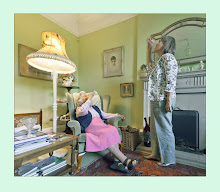Tate Britain does not often show photography but the Tate as a whole has made a committment to showing photography, recognising it as an art form. However, one wondered what had made them choose Edweard Muybridge, whose work could be shown in a science museum since his photographic studies of locomotion in both animals and humans, led to a better scientific understanding of motion as a whole.
Some of Muybridge's early work reveals landscapes photographed with great attention to detail which are given wider impact by an artistic sensitivity towards composition. Using a large camera with the wet-plate collodion process (he continued with this method until the 1880's) that produced sizeable contact prints, he made images that predate and resemble those that Ansel Adams was to make in the following century for Muybridge worked a great deal in the Yosemite National Park.
Muybridge's photographs from the 1870's of San Francisco contain among them detailed 360 degree panoramas of the city before it was destroyed in the 1906 earthquake and fire. They also show the area before the building of the Golden Gate Bridge which opened in 1933.
However, Muybridge is best known for his studies of motion, made with a line of cameras that were fired one after the other by the subject passing and setting off the shutter by a trip wire. The old age question of whether that had been discussed as far back as the ancients of Greece, of whether a galloping horse ever left the ground completely or always had a foot on the ground, was finally solved; a horse when galloping can be entirely off the ground at a given moment since Muybridge was able to photograph this and show the different movements that led up to and followed it.
Although Muybridge did not actually invent cinematography, he certainly anticipated it as he did many other things. One might point to the case of O.J.Simpson who many consider escaped justice after killing his wife and her lover for Muybridge on discovering his wife had an affair, went out and shot the offending man, a theatre critic, and was eventually acquitted by a jury.
Yet, Muybridge also influenced many artists which is perhaps the main reason his work is being shown at Tate Britain. Degas is one artist who copied directly from his work, with one of his bronze sculpture's being of an image of a horse called Daisy and named 640 after a negative that had recorded it. Muybridge was aware of just how little artists really new about motion and so was able to show them not just a new way of conveying it but of a much more realistic one too though many may not have fully realised this at the time.
The surrealists were also affected by Muybridge's studies as were more recent artists such as Francis Bacon. Yet his work also influenced many photographers.
If Art can be said to make us see the world differently then Muybridge is a great artist and a realsitic one too.

I am intrigued by your choice of book partly because I attended the Tate Modern seminar on the representation of violence that followed in the wake of the EXPOSED exhibition. Is Sontag really saying that we have become inured to photographs of suffering? In her book, In Regarding the Pain of Others, she actually writes … “our capacity to respond to our experiences with emotional freshness and ethical pertinence is being sapped by the relentless diffusion of vulgar and appalling images – might be called the conservative critique of the diffusion of such images. I call this argument conservative because it is the sense of reality that is eroded. There is still a reality that exists independent of the attempts to weaken its’ authority.” (p.97 Penguin Edition 2004) which I consider is a vital statement of her outlook. Elsewhere, she admits that “There are hundreds of millions of television watchers who are far from inured to what they see on television. They do not have the luxury of patronising reality.” (page 99).
Sontag is however tends to be regarded as gospel and I do not think she is; her statements are rather sweeping!
Jose
What a wonderful book you have come across! such books are a bit of a luxury and although Amazon offer it at a reasonable price, it is a matter of whether I’ll have room for it. Maybe … these days I am my own Santa so its’ possible! The Antarctic may not be there much longer so these are poignant landscapes.
As for my own choice, it is rather personal. The Indians by Raghu Rai does not seem to be available through Amazon and the cost in Delhi of £80 seemed too exorbitant. Nevertheless, I was shown a copy. It starts with a collection of Rai’s old portrait photographs, images from a bygone era when Britain ran the country; these show something of an India that is no more. This is followed by Raghu’s own photographs and features portraits of famous Indians such as Mother Teresa (actually a European) and Indira Gandhi as well as some of the great musicians (Hariprasad Chaurasia for instance). My favourite portrait is that of Jiddu Krsnamurti, a teacher who is still recognised worldwide; he is portrayed in a triptych that suggests both agony and ecstasy. The one that made me laugh is of Moraji Desai, a former prime minister who seems to be glaring defiantly down Rai’s lens; Desai was also famous for drinking his own urine, a nature cure!
I would also like to mention Michael Freeman’s Photographer’s Mind. What I like about his books is the way they bridge the gap between critic and photographer.